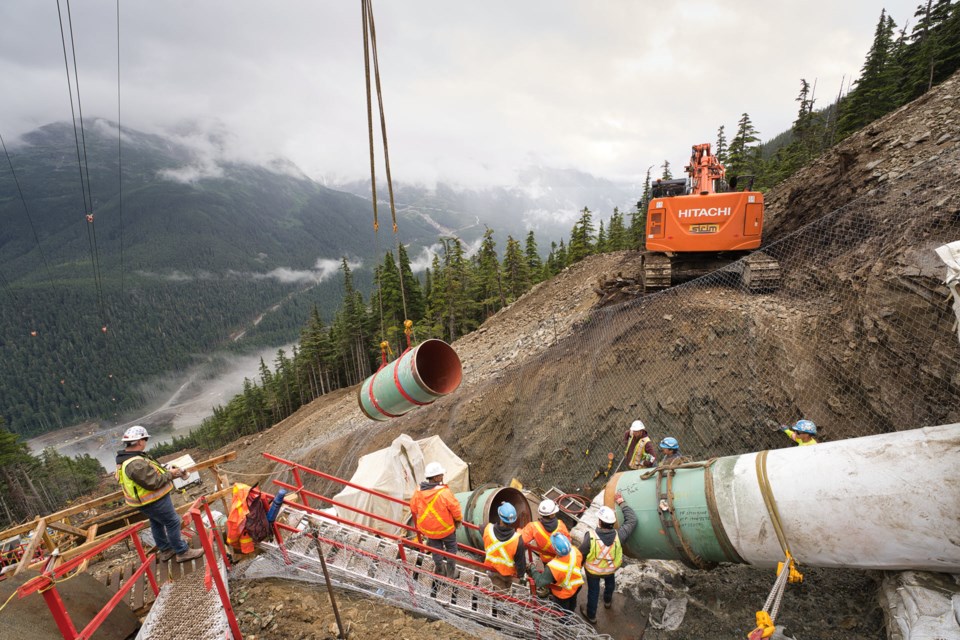A legal challenge to the construction of a section of a major gas pipeline project in northern B.C. has been thrown out by a judge.
The roughly 900-kilometre-long Prince Rupert Gas Transmission project is meant to transport natural gas from Hudson’s Hope in northeastern B.C. to the proposed Ksi Lisims liquefied natural gas export terminal 82 kilometres north of Prince Rupert.
The BC Energy Regulator (BCER) had previously issued permits for seven sections of the pipeline. In response, Skeena Watershed Conservation Coalition, the Kispiox Valley Community Centre Association, and the Kispiox Band filed a request for judicial review challenging a BCER decision to allow construction on a section of the pipeline known as Section 5B.
The three groups argued that the BCER unlawfully permitted construction without a new cumulative effects assessment, as required by one of the permit conditions. Such an assessment should consider the total additive impacts of the pipeline and other industrial development across the landscape — up and downriver of the project, they said.
In response, the BCER and Prince Rupert Gas Transmission Ltd. argued in court that the petitioners did not have the standing to bring the lawsuit.
B.C. Supreme Court Justice Michael Tammen found challenging a single piece of the pipeline was not a "serious issue of public importance."
His ruling also found the Kispiox Band Council is not the rights and title holder for the Gitxsan people, whose hereditary chiefs have a project agreement with PRGT Ltd. and did not raise the same concerns.
Matt Hulse, one of the three groups’ lawyers, said in a statement that they were disappointed that the court ruled that no one other than the project proponents could challenge the regulator’s decision to allow construction to go ahead.
Shannon McPhail, Skeena Watershed Conservation Coalition’s co-executive director, said that by rejecting the three plaintiffs standing, courts have yet to answer whether the BCER adhered to its own permit conditions and B.C. legislation.
“This should be a wake-up call for all British Columbians that our energy regulator is not looking after the public interest,” said McPhail.
The BCER turned down a request to comment on the case. A lawyer for Prince Rupert Gas Transmission Ltd. said he was not immediately available to comment.
The pipeline and the export terminal it feeds have been a flash point for opposition to expanded fossil fuel production.
When up and running, Ksi Lisims is expected to produce up to 12 million tons of liquefied natural gas per year, while consuming roughly the equivalent amount of energy produced by the Site C dam.
Proponents of the project have cited its financial benefit to Canada and the prospect of displacing coal-burning power plants in Asia.
Opponents question that potential and point to natural gas's role in heating up the planet — the main ingredient in gas is methane, and when it leaks into the air, it acts as a greenhouse gas 80 times more powerful than carbon dioxide over the first 20 years in the atmosphere.
They also point to the proposed path of the pipeline, and how it passes through more than a thousand waterways and a number of ecological reserves, including the Nisga’a Lava Bed Memorial Protected Area.
Section 5 of the pipeline begins east of the Skeena River, and passes 13.5 kilometres northeast of Kispiox 1 Reserve. Heading west, the proposed pipeline path passes around the Nass Mountain Ranges, and runs through the Nass Valley and Nisga'a Lands toward the coast.
The western portion of the proposed pipeline, including the 77-kilometre-long Section 5B, lies entirely within Nisga’a Lands and outside the Skeena River watershed and Kispiox Valley.
The petitioners told the court they “cannot wait until construction starts in Section 5A to bring this challenge because the effects of Section 5B construction extend outside of Nisga’a Lands.”
In submissions, Kispiox Band said it would be affected by construction of Section 5A and Section 4 of the pipeline, as well as compressor stations, and construction camps.
Pipeline sections do not impact people or the landscape in isolation, they argued.
Tammen disagreed. The judge said the Nisga'a Nation, which owns the land along Section 5B, supports the permit decision, and as a result, the petitioners lacked a "genuine interest.”
“To some extent, Skeena and Kispiox CCA appear to be ‘busybody’ litigants, seeking to challenge a micro-decision made in the course of a much larger project when that decision does not meaningfully affect them,” wrote the judge.
He did not extend that description to the Kispiox Band, but rejected its standing in the case because it does not hold rights and title for the Gitxsan people.
“There will be an opportunity for all three petitioners to make their opposition to the project known, when permitting decisions that directly impact their interests are made,” wrote Tammen.
The petitioners have 30 days to file an appeal. Hulse said his clients are still weighing that option.



